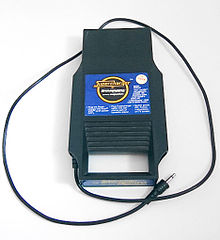 The Supercharger and a few game boxes The Supercharger and a few game boxes | |
| Design firm | Starpath |
|---|---|
| Manufacturer | Starpath |
| Introduced | August 1982; 42 years ago (1982-08) |
| Discontinued | 1984 (1984) |
| Cost | 69.95 US$ (included one game: Phaser Patrol) |
| Type | Expansion peripheral cartridge |
| Memory | 6 KB RAM |
| Connection | Cable earphone jack for cassette |
The Starpath Supercharger (originally called the Arcadia Supercharger) is an expansion peripheral cartridge created by Starpath, for playing cassette-based proprietary games on the Atari 2600 video game console.
The device consists of a long cartridge with a handle on the end, and an audio cassette cable. It adds 6 KB to the Atari 2600's 128 bytes of RAM (increasing it 49-fold to 6,272 bytes of RAM), allowing for the creation of specially compatible games which are larger and have higher resolution graphics than normal cartridges. A cable coming out of the side of the cartridge plugs into the earphone jack of any standard cassette player, for loading all Supercharger games from standard audio cassettes.
Games
All Supercharger games were developed by Starpath.
- Initial releases
Listed in order of release:
- Phaser Patrol
- Communist Mutants from Space
- Fireball
- Suicide Mission
- Escape from the Mindmaster (prototype is called Labyrinth)
- Dragonstomper (prototype is called Excalibur)
- Killer Satellites
- Rabbit Transit
- Frogger, The Official
- Party Mix
- Mail order releases
These games were available only via mail order after Starpath declared bankruptcy.
- Sword of Saros
- Survival Island
- Prototypes
- Sweat: The Decathlon Game
- Going Up??
Compatibility

The Supercharger is compatible with Atari 2600, Atari 2600 Jr., and the Sears Video Arcade consoles.
Due to the shape of the Supercharger, it does not normally fit into the ColecoVision's Expansion Module #1, which is an adapter that allows the ColecoVision to play Atari 2600 games. However, if the cover of the expansion module is removed or an extender is used, the Supercharger will work. Extenders were sent to customers who called Starpath about such issues.
The Supercharger does not work on many Atari 7800 systems (which is typically backward compatible with the Atari 2600), although it does with some early models of the system. After Atari installed a circuit to fix a compatibility issue with the 2600 version of Dark Chambers, it subsequently caused incompatibility with the Supercharger and some other games that use the FE bank switching method.
Reception
Danny Goodman of Creative Computing Video & Arcade Games said that the Supercharger's "graphics are something else", reporting that the diagonal lines in one game under development were among the smoothest he had seen in any console.
Legacy
The complete library of games, including the prototype Sweat, was also released on audio CD as Stella Gets A New Brain by CyberPuNKS (Jim Nitchals, Dan Skelton, Glenn Saunders and Russ Perry Jr.). There are two releases, both sanctioned by Atari and Bridgestone Multimedia, who had obtained the rights to the Starpath library some time ago. The first release is a limited number not-for-profit product, which also includes the previously unreleased Atari prototype, Polo by Carol Shaw. The second release includes the Supercharger prototypes Meteoroid (an early version of Suicide Mission) and Excalibur (an early version of Dragonstomper), in addition to a number of homebrew games by permission of their respective authors, and the song Atari 2600 by Splitsville, fully licensed from the band.
References
- ^ Upgrades Atari Capacity:Arcadia Sets 'Supercharger Unit, By John Sippel, Page 32, Billboard, 21 Aug 1982, ...comes to market later this month...
- Yarusso, Albert. "Companies: Starpath". AtariAge. Retrieved December 3, 2010.
- Grand, Joe; Thornton, Frank; Yarusso, Albert (2005). Game console hacking: have fun while voiding you warranty. Syngress. pp. 393, 504. ISBN 1-931836-31-0.
- Carless, Simon (2005). Gaming Hacks: 100 Industrial-Strength Tips & Tools. O'Reilly Media. pp. 15–16. ISBN 0-596-00917-8.
- Herman, Leonard (1997). Phoenix: The Fall & Rise of Videogames. Rolenta Press. p. 277. ISBN 0-9643848-2-5.
- Games Department: Atari VCS, By Dan Gutman, ANTIC VOL. 2, NO. 2 / MAY 1983
- Advertisement:Silica shop:Supercharger Page 19, Computer and Video Games Magazine Issue 021, Published July 1983
- Article:Surpercharge a VCS and load up games from cassette tapes Page 20-21, Computer and Video Games Magazine Issue 021, Published July 1983
- Survival Island (1982)(Demo) on YouTube
- The Dot Eaters - Epyx | The Dot Eaters, Scott Nelson, one of the former Starpath programmers, had created a decathlon game for the Supercharger called Sweat!, but when the company merges with Epyx the project is shelved.
- Goodman, Danny (June 1983). "Starpath's Supercharger for Atari". Radio-Electronics. Vol. 54, no. 6. pp. 65–67.
- Yarusso, Albert (2004). "Chapter 7: Hack Your Atari 2600 and 7800". In Grand, Joe (ed.). Hardware Hacking: Have Fun While Voiding Your Warranty. Syngress. pp. 228–232. ISBN 1-932266-83-6.
- Goodman, Danny (Spring 1983). "Home Video Games: Video Games Update". Creative Computing Video & Arcade Games. p. 32.
- "Suicide Mission". Atariprotos.com. Retrieved 2021-01-25.
- "Dragonstomper". Atariprotos.com. Retrieved 2021-01-25.
External links
- STARPATH/ARCADIA FAQ, last modified 1/5/1995
- GENERAL STARPATH SUPERCHARGER QUESTIONS, CYBERPUNKS" Project FAQ, last modified 3/5/2000 by Glenn Saunders
| Atari 2600 | |||||||||
|---|---|---|---|---|---|---|---|---|---|
| Games |
| ||||||||
| Hardware | |||||||||
| Emulation and ports | |||||||||
| Related articles | |||||||||
| Category | |||||||||